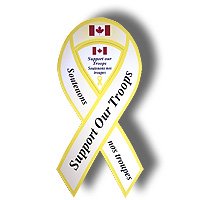In Booming Petawawa, No Sign of a Postwar Slowdown
By Don Butler, Postmedia News
Ottawa Citizen reporter, Tony Lofaro (L) talks with Jihan Falah (R), mother of Marc Diab, in front of The Madameek Restaurant, on July 23, 2010, in Petawawa, Ont. As a way of dealing with their grief and honouring their son, Marc Diab, who was killed in March 2009 by an IED, the Diab's opened the restaurant in Petawawa. Marc Diab's photo is on the rear window of his jeep.
Photograph by: Jana Chytilova, Ottawa Citizen
With troops home from Canada's combat mission in Afghanistan and a new helicopter squadron en route, CFB Petawawa is fuelling an economic boom in this Eastern Ontario community.
There's no post-mission slump here. Instead, Petawawa Mayor Bob Sweet says the town's economy sagged at times during the mission, because so many troops were overseas. There were fewer people to buy groceries, new cars and other goods.
"I always say that Petawawa is kind of recession-proof, because you don't lay soldiers off when there's a downturn in the economy," says Sweet. "But when you send abroad 2,000 individuals, it's virtually the same thing."
But now, as Canada's war in Afghanistan is morphing into smaller training mission, the communities around the country's "super-bases" — like Petawawa, Edmonton and Gagetown, N.B. — are undergoing a major shift.
And with nearly 5,000 soldiers and 900 civilians on the payroll, CFB Petawawa is by far the upper Ottawa Valley's largest employer, pumping between $400 million and $500 million a year into the regional economy.
About 60 per cent of the soldiers live off base in Petawawa, Pembroke and other Ottawa Valley communities. As they returned from major deployments in 2006, 2008 and 2010, flush with money earned in combat, many decided to buy a home, says Judy DeGeer, owner of RE/MAX Pembroke Realty.
"The common comment I got was, 'I worked extremely hard and put my life on the line for this money. I need to make a wise investment with that,'" DeGeer says. The result has been a frenzy of homebuilding in Petawawa.
"Over the last three or four years, I suppose we've built a small community," Sweet says. About 800 new homes have gone up, with another 1,200 or so planned.
With nearly 16,000 residents, Petawawa is already the largest community between Ottawa and North Bay. The population is expected to spike to about 19,000 by 2020, Sweet says. One new school is almost built and funding is in place for another.
The federal government's decision to base Canada's new fleet of 15 Chinook helicopters at CFB Petawawa is also goosing the town's growth. The first 100 soldiers will arrive in May and the new helicopter squadron will become fully operational next year. When fully staffed, it will bring 400 to 500 soldiers plus their families to Petawawa.
Construction began about a year ago on a massive $135-million hangar, nearly a kilometre in length. "It's a beast of a construction," says Lt.-Col. Chris Moyle, the base commander. The military expects to spend $835 million on new buildings and infrastructure related to the new helicopter squadron by 2020.
Until now, commercial development hasn't kept pace. The town lacks a proper downtown — Petawawa Boulevard, the main drag, is a nondescript array of strip malls, convenience stores and fast-food outlets — and there's a dearth of stores and services. Most residents make the 20-minute drive to Pembroke for serious shopping.
That's starting to change. Several new businesses have opened in recent years — many run by retired military personnel — and a 350,000-square-foot shopping centre is planned for 2013.
That's good for Petawawa, but it could hurt established businesses in Pembroke, says Gary Melnyk, president of the Upper Ottawa Valley Chamber of Commerce. "You'll have fewer people from Petawawa coming to Pembroke to do their shopping."
One Petawawa business that's thriving is the Madameek, a restaurant that serves authentic Lebanese food. Trooper Marc Diab's relatives opened it in 2010, a year after Diab was killed by a roadside bomb north of Kandahar.
The place is a tribute to the 22-year-old Petawawa soldier, who dreamed of opening a shawarma restaurant in the town. It's such a roaring success that the owners are on the verge of opening a second location in Pembroke.
"This kind of food, they don't have it here. And they like it." says one of the owners, Ghassen Ghanem, Diab's brother-in-law.
A steady stream of customers, many in uniform, stop by to pick up lunch. "It's a little bit slow," Ghanem observes. "Usually they're lined up."
He credits Diab for the business's success. "He's watching us, I'm 100 per cent sure, from the sky, and he blessed everything. That's why everything is OK."
With the rapid growth comes challenges. Some weekday mornings, the town's main street, Petawawa Boulevard, is backed up for two or three kilometres as soldiers and civilian employees head to work on the base. "It's hard to imagine," marvels Sweet. "We've got gridlock here in the Upper Ottawa Valley."
Fixing that won't be cheap. A two-lane bridge over the Petawawa River would have to be replaced to widen to road into the base to four lanes. The town is doing a feasibility study.
It's also spending millions to expand its sewer and water system, which CFB Petawawa relies on to meet its needs. But the base offers plenty in return, including fabulous facilities open to townsfolk at minimal cost.
Local residents can use the base's 18-hole golf course, sail at its yacht club, watch first-run movies at its theatre and work out at its world-class fitness centre, which features a track, two sheets of ice and indoor rock climbing walls.
The facilities were built to serve the needs of the soldiers and their families, says Moyle, who calls the base "a gem within a gem. If we can extend that capacity to the small communities that are around us, I think that just makes us better community partners."
The town has a "wonderful relationship" with the base, Sweet says. "We meet on a regular basis with the base team. It's a healthy relationship and one that's worked quite well."
That wasn't always the case. Soldiers used to rotate out every three years, and more lived on the base. "There was very much a division between the base and the military and ourselves," says Sweet.
Posting out is less frequent now. Some soldiers stay in Petawawa for a decade or more. "We get to know our neighbours an awful lot better," says Sweet. "You go to dances with them or play golf with them."
The base's soldiers are so well integrated that when they were deployed to Afghanistan, it created something of a crisis for sports and other volunteer groups, which rely heavily on them as coaches and organizers. "They're tremendous volunteers and they very much want to be part of our community," Sweet says.
But every silver lining has a dark cloud. Amanda Cheverie, whose husband is ex-military, opened her store, Full Spectrum Gear, in 2007, just before a deployment to Afghanistan.
Soldiers lined up for the store's outdoor tactical equipment. But over the last year, business has fallen off. Post-mission, soldiers don't need the kind of gear Cheverie sells. "I would say that 50 per cent of what I sell has come to a screeching halt or has slowed down noticeably."
Cheverie is adjusting. There are plans to sell firearms and ammunition. "Realistically," she says, "they never go out of style. I knew they wouldn't be in Afghanistan forever, and you have to evolve with the times."
Ottawa Citizen
dbutler@ottawacitizen.com
CFB Petawawa at a glance
Location: Petawawa, Ont., 160 kilometres northwest of Ottawa
History: Founded in 1905 as Camp Petawawa, a summer training ground for the Canadian militia. During the Second World War, as many as 20,000 soldiers were stationed there for training. Renamed CFB Petawawa in 1968 following armed forces unification.
Size: More than 600 buildings, 1,600 housing units, 340 square kilometres of training area and a workforce of 6,000.
Resident military personnel: Fluctuates between 4,000 and 5,000
Civilian employees: 900
Components: 2 Canadian Mechanized Brigade Group, which includes the Royal Canadian Dragoons, Two battalions of the Royal Canadian Regiment and the second regiment of the Royal Canadian Horse Artillery, among others. Also home to 2 Area Support Group, the Canadian Special Operations Regiment, medical units, military police and other support units.
Deployments to Afghanistan: Major deployments in 2006, 2008 and 2010, plus several smaller deployments.
Casualties: 40 soldiers from units based at CFB Petawawa have died in Afghanistan.



























No comments:
Post a Comment